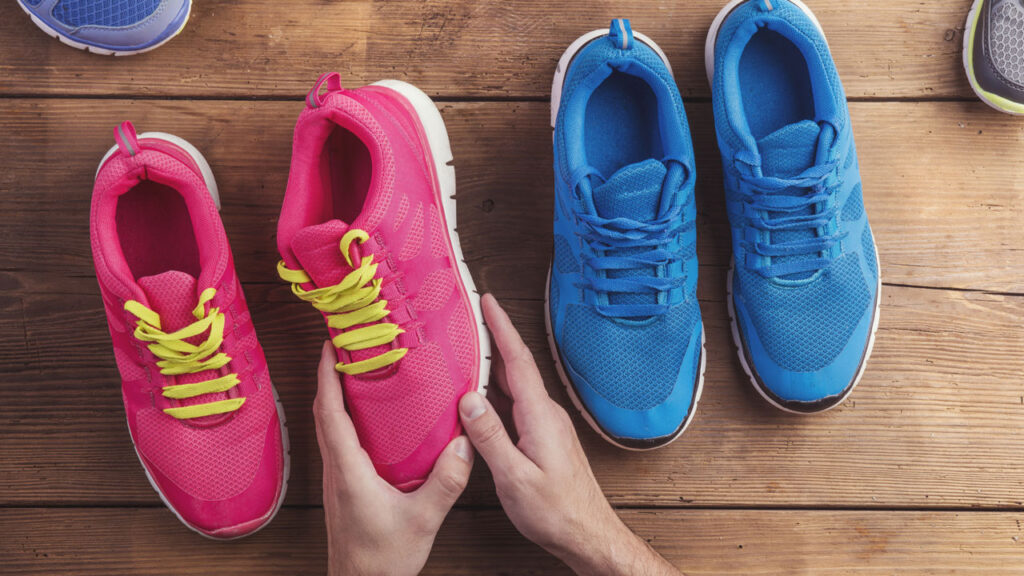One of the benefits of walking is that it doesn’t require a big budget, but investing in a good pair of walking shoes is key. Here are some tips to help you get the best fit.
Before you go to the store:
Measure your feet. It’s natural for your feet to change in length and width over time. Our bodies absorb 2-3 times our weight as we walk. Over time, the ligaments and tendons that support the arches of our feet become worn from use. Our arches slowly collapse, which causes our feet to become longer and wider.2 Be sure to stand while having your feet measured because the full weight of your body will expand your feet, which will give you the most accurate measure for choosing your shoes.1
Bring your socks. Always try shoes on with the socks you plan to wear for your walking workouts. (If you wear orthotics – specially designed inserts – be sure to bring those as well).
Consider your specific foot type, including arch type and gait. How high the arch of your foot is can affect how you walk. The arch of your foot can be, high, neutral (also called medium or normal), or low (also called flat feet). To learn your arch type at home, you can use a wet foot test.3 Your gait is the way you walk, and importantly, how your foot strikes the ground.
As you walk, you might overpronate, strike neutrally, or underpronate.
- Overpronate: Overpronation occurs when your foot collapses too far inward onto the arch each time you step. This is common for those with low arches or flat feet.4 Look for a shoe designed for stability and motion control.5
- Neutral foot strike: As you walk, your foot typically rolls from heel to toe with a slight inward roll (pronation), which is normal and helpful, allowing the foot to absorb shock and mold to the surface of the ground.6 Your arch naturally supports your body weight under a normal load. Look for a shoe with a firm midsole4 and equal amounts of stability and cushioning.5
- Underpronate: Underpronation occurs when your foot strikes too much on the outside of the foot and doesn’t have enough of an inward roll.4 This is common for those with high arches. Those with feet that underpronate are less able to absorb shock.6 Look for shock absorption in a shoe with plenty of cushioning, a softer midsole, and more flexibility.5

At the store:
Try on several pairs of shoes of different brands. Keep in mind, every shoe manufacturer uses a different basic shoe shape (last) – some shorter or longer, some wider or narrower.10 Since we all have different feet, what works for one, might not work for another. Try different brands to assess what’s best for your feet.
Choose the right size by measuring from the longest toe. Be sure there’s about ½ inch of room at the front of the shoe between your longest toe (not necessarily the biggest toe) and the front end of the shoe.
Choose the shoe that fits your largest foot. About 60% of adults have one foot that’s longer and/or wider than the other.11 If you have a wider foot, ask for shoes in wider widths. If your feet are a full size or more different from one another, consult your doctor or podiatrist.
Additional tips:
Try shoes on late in the day. Feet can swell up to 8% throughout the day.1 So, try shoes on in the afternoon or at the end of the day when your feet are swollen from use.
The American Podiatric Medical Association recommends replacing your walking shoes every 600-800 miles or every 6-8 months.13 This is a general guideline, so be sure to check your shoes for wear or discomfort. If they’ve become uncomfortable or lost shock absorption or stability, it’s likely time for a new pair.
“Don’t cut corners on your shoe budget; buying shoes is the only real expenditure necessary for the sport, so treat your feet well.”10
Is it ok to wear running shoes for walking? In short, yes. According to the American Academy of Podiatric Sports Medicine, “The ideal walking shoe should be stable from side to side, well-cushioned, and it should enable you to walk smoothly. Many shoes fit all of these criteria well, and for most people are acceptable for a walking program.”13 You can also choose a specialty walking shoe if you prefer the fit. “Most important, whether you are wearing a walking or running shoe, is that it must feel stable to you. Either type of shoe is acceptable if it works well with your foot mechanics, providing cushioning and stability.”13
Athletic shoes can be expensive, but investing in the right pair of shoes can save you from problems later. The way we walk can affect not only our feet and ankles, but also other parts of our body like our shins, knees, hips, and spine.1,6,7 Take good care of your body by investing in good shoes.
Infographic
Download the PDF or share the image below to help others learn how to choose walking shoes.
- Weatherford BM, Irwin CK. Shoes: Finding the right fit – American Academy of Orthopaedic Surgeons. https://orthoinfo.aaos.org/en/staying-healthy/shoes-finding-the-right-fit. Published April 2019. Accessed April 19, 2023.
- Nicolosi N. Shoes getting tight? Why your feet change size over time. Cleveland Clinic. https://health.clevelandclinic.org/shoes-getting-tight-feet-change-size-time/. Published September 19, 2022. Accessed April 19, 2023.
- Mayo Clinic Health System. Determining your foot arch. https://www.mayoclinichealthsystem.org/-/media/national-files/documents/hometown-health/2019/determine-your-foot-arch-type.pdf?la=en&hash=4138E8975488D0075B78FF0BA2E0FD1F. Published 2018. Accessed April 19, 2023.
- Weber M. How to determine foot arch type. Mayo Clinic Health System. https://www.mayoclinichealthsystem.org/hometown-health/speaking-of-health/how-to-determine-foot-arch-type. Published March 23, 2022. Accessed April 19, 2023.
- American Podiatric Medical Association. Which running shoe is right for you?: Tips for healthy feet: Patients. https://www.apma.org/runningshoes. Accessed April 19, 2023.
- Walden M. Supination (foot biomechanics). Sportsinjuryclinic.net. https://www.sportsinjuryclinic.net/treatments-therapies/foot-biomechanics-gait-analysis/over-supination-foot-biomechanics. Published February 15, 2023. Accessed April 19, 2023.
- Nesbitt L. How to buy Athletic Shoes. The Physician and Sports Medicine. 1999;27(12):133-134. doi:10.3810/psm.1999.11.1130.
- Coburn JW, Malek MH. NSCA’s (National Strength & Conditioning Association) Essentials of Personal Training. Second ed. Champaign, Illinois: Human Kinetics; 2011. Excerpt retrieve from https://www.nsca.com/education/articles/kinetic-select/six-essentials-to-safe-participation/, April 17, 2023.
- Christensen B, Edwards JU. Walking: Select the right shoes. North Dakota State University. https://www.ndsu.edu/agriculture/sites/default/files/2022-09/fn603_0.pdf. Published August 2022. Accessed April 19, 2023.
- American Academy of Podiatric Sports Medicine. Walking and your feet: Choose proper walking shoes. http://www.aapsm.org/walking.html. Accessed April 19, 2023.
- Priority Podiatry. Is it normal for one foot to be bigger than the other? https://prioritypodiatry.co.uk/2021/06/11/is-it-normal-for-one-foot-to-be-bigger-than-the-other/. Published June 11, 2021. Accessed April 19, 2023.
- Public Broadcasting Service. America’s walking: Picking the right walking shoe. https://www.pbs.org/americaswalking/gear/gearpicking.html. Published 2002. Accessed April 19, 2023.
- American Podiatric Medical Association. Choosing shoes for sports: Tips for healthy feet: Patients. APMA. https://www.apma.org/sportspecific. Accessed April 19, 2023.




